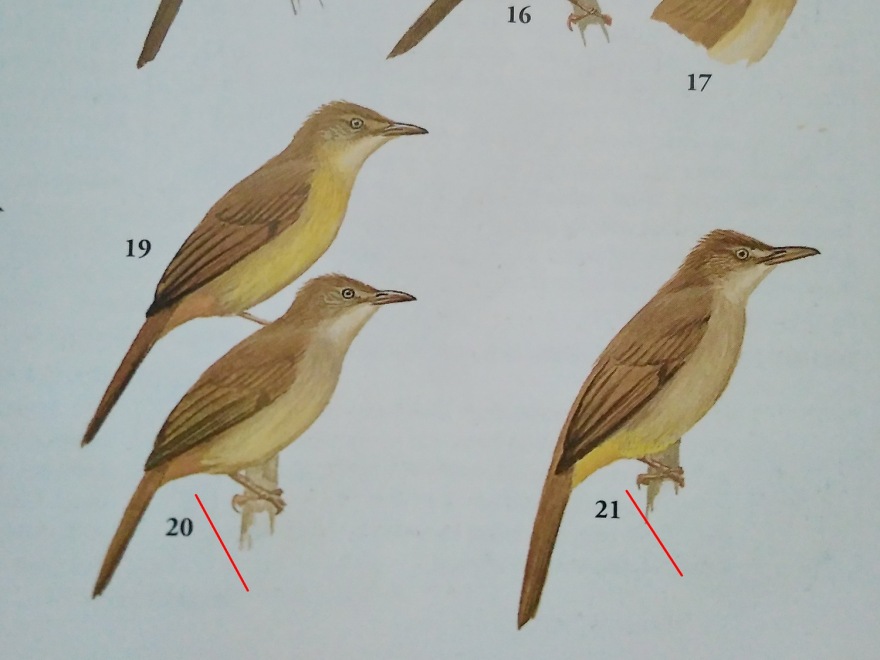
Late last year Thai birdwatchers received an early Christmas present: a new bird for the Thai lists.
Whether it be a new species or a split, a new bird for the country is always a great reason to celebrate. In the game of birdwatching, adding a newcomer to the list helps to keep the ball rolling. It helps to keep those with fewer numbers busy while muzzling the players with higher numbers from bragging too much. – But birdwatching isn’t just about games, it’s also about science. – And splitting species isn’t just another effort to keep greasing the wheels of the tourism and commercial air travel: it’s a way of helping us comprehend the magnitude of creation and appreciate the immense diversity of Mother Nature.
So I’m going to start out by announcing the latest addition to our Thailand lists: Ladies and gentlemen, may I introduce to you Baker’s Bulbul Iole cinnamomeoventris.

– Now to get down to the difficult part of explaining where it came from.
In Round and Lekagul’s 1990 Field Guide to Birds of Thailand, we find a number of bulbuls classified under the genus Hypsipetes. Then in 2007 Craig Robson’s offering by the same name we find all but three species of the genus Hypsipetes have been cleared out and replaced by Iole. (The most recent IOC List for Thailand only has one Hypsipetes remaining.) Birds which had their name tags switched include the Buff Vented Bulbul Iole olivacea*, Olive Bulbul Iole virescens and Grey eyed Bulbul Iole propinqua. Within the Grey eyed Bulbul group we also find three resident subspecies: I.p cinnamomeoventris, I.p lekhakuni and I.p simulator.
It’s around this time in the post when you, the reader, decides it’s time to hit the snooze button and nod off while I ramble on about binomial nomenclature, Phylogenetics and other “cool” stuff in Latin which you probably think I made up on a night out with Jack Daniels. Truth be told, I would very much appreciate that you snoozed off now because I, like you, may (in an abashedly truthful confession) have little idea of what I am talking about. Bottom line, I am completely confounded by this scientific stuff which is WAY above my pay grade. Nothing in highschool could have prepared me for this, and by this I mean the scientific paper which details these groundbreaking discoveries.
If you want to have a crack at it, click here.
Sadly, I didn’t have any “crack” to smoke while attempting to decipher this extremely detailed document, the likes of which could probably pass for a bomb defusing manual. It was around this time that I decided to pick up the phone (or in this case the computer keyboard) and send out a tearful S.O.S to my good friends further up the Life List Ladder. -And like all good friends do, someone threw a lifesaver my way.
So let me have a go at this:
First off, we discovered that everything we thought we knew about these bulbuls was let out to pasture. These Little Brown Jobs (LBJ) turned out to be a much bigger handful than we expected.
As you may have already guessed, Bakers Bulbul is (was) a subspecies of Grey eyed Bulbul which has been upgraded to its own full species. Here comes the twist: after DNA investigation, cinnamomeoventris is actually closer related to Olive Bulbul I. virescens than it is to Grey eyed Bulbul I. propinqua, meaning it should have been a subspecies of virescens instead propinqua? – Huh???
So to make it clear:
1: Grey eyed Bulbul is no longer a southern bird. The three remaining I. propinqua subspecies are found only in the north and northeast (I.p propinqua), east (I.p simulator) and west (I.p lekhakuni).
2: Any Grey eyed Bulbuls found in the south are now known as “Bakers Bulbul” I.p cinnamomeoventris.
So we’re done here, right? – Buckle up fellow birders, we’re just getting started!
Now comes the fun part: identifying the bird.

As its name suggests, the Grey eyed Bulbul (now Bakers Bulbul) has a grey eye (or whitish, depending on what art school you graduated from in kindergarten). –Sounds easy to identify, right? –WRONG! Let me remind you that the Red eyed Bulbul, a bulbul appreciated for its wine-tinted oculus is one of THREE species which have red eyes, the other two being the Olive winged and Spectacled Bulbul. Misidentification is rife among the uninitiated and numerous first-timers to Thailand and naïve photographers have fallen prey to this misleading name. –Ask Facebook if you don’t believe me.
So back to the Grey eyed Bulbul: This is a bird which completely lives up to its LBJ namesake. Its brown all over, has no complicated song, moves around in bunches and chirps and burps like the rest of them. It would be easy if there were only one type of boring bulbul to hang with but no, Mother Nature in all her impish knavery had to throw in another near-identical LBJ: the Buff vented Bulbul I. olivacea.
I. olivacea is another can of worms I don’t want to pry open at this time but readers should be aware that this is another family which is under investigation and may soon spawn a whole new set of splits themselves. (Please also refer to the footnote at the bottom which covers the issue of scientific name changes being tossed around.) Basically the whole thing wouldn’t be an issue for local birders except that (again, THANK YOU Mother Nature) distribution of both I. olivacea and I.p cinnamomeoventris overlap in southern Thailand.
-At least according to the map included in the paper:

The distribution map included in the paper was, in my opinion, the simplest way of explaining the split and helped to explain things in a much more down-to-earth manner. Like they say, a picture is worth a thousand words.
According to this map both I. olivacea and I.p cinnamomeoventris can be found from Chumphon south to Songkhla and the border with Malaysia. Some birders have claimed to have found both species at sites such as Ngao and Sri Phang Nga National Park. I am fairly certain that I have seen both species at different locations along the west coast but ever since I started photographing bulbuls three years ago I have still never photographed Iole olivacea in the region. Dave Sargeant believes that they are present further south in Hala Bala but are not present further north of Songkhla and judging by my recent experiences I tend to agree with him.
So how do we differentiate between the two in the field? I’ll try to sum it up in a very simple way so as to avoid the need for coffee, paracetamol or brain-replacement surgery.
Let’s start with the Grey eyed Bulbul (now known as Bakers Bulbul). Assuming that the Grey eyed should be easily told apart from the Buff vented Bulbul by simply looking at the color of the eye is a mistake many birders (including myself) have fallen for. Why? –Well, both species have whitish eyes.
So what are we looking for here?
A clue of what to look for can be seen in the illustrations found in Robson’s Field Guide to Birds of Thailand:

Yes, the vent.
Drawings however, can be misleading and may I remind you that while the text describes four subspecies of propinqua, only two illustrations are shown. That itself should make a birder wary of leaning too hard on the illustration when attempting to differentiate between the two.
Andy Pierce, a longtime birder in Thailand once asked me how I differentiated Grey eyed from Buff breasted, to which I confidently responded “By looking at the vent”. Childish enthusiasm may have saved the day for me back then but I later found out that despite my lucky conclusion, the issue was a much deeper one than I had even begun to comprehend.
According to Andy, photographic examination of the vent of Iole olivacea (Buff vented Bulbul) will show faint scaling on the sides of the vent with a pale yellow center and a very light brown on the sides of the vent and a darker center closer to the under tail coverts.
I say photographic because unless you are holding the bird in your hand or have your face uncomfortably close to its privates, you’re most likely not going to pick up these subtle markings.
I.p cinnamomeoventris (Bakers Bulbul) will show (at times) a darker vent which contrasts with the belly. There is no scaling on the vent, which is a uniform color throughout.
Theoretically if the birder has really close views of the bird at the best angle with perfect lighting the whole session should be a wrap. Of course we know how that usually works out. What happens in a perfect world … well, only happens in a perfect world.
To simplify things we turn to our failsafe which happens to be bird calls. This is simply the best and quickest way to properly sort one from the other. For that reason, I have included the call of I.p cinnamomeoventris along with that of I. olivacea. Both are very similar but the call of I.p cinnamomeoventris is more drawn out than that of I.p olivacea. Study it carefully please.
Bakers Bulbul, though formally announced as a new species, is still being researched and a complete paper will be published on the matter in the future. Keep an eye out for more additions and changes coming over the horizon as it seems there is a lot more we can learn about these boorish bulbuls.
I would like to thank Dave Sargaent for his help in explaining the paper and sharing his findings with me. Andy Pierce helped explain the identification of Iole olivacea and Phillip Round shared the link to the paper as well as information on the split with me.
* Buff Vented Bulbul was formerly known as Iole olivacea and while some still use the name, others have declared it invalid, choosing to go with Charlotte’s Bulbul Iole charlottae. There are three subspecies: I.c crypta, I.c perplexa and I.c charlottae. Of the three, I.c crypta is found in southern Thailand and is the one most likely to take on the mantle of Buff vented Bulbul.
